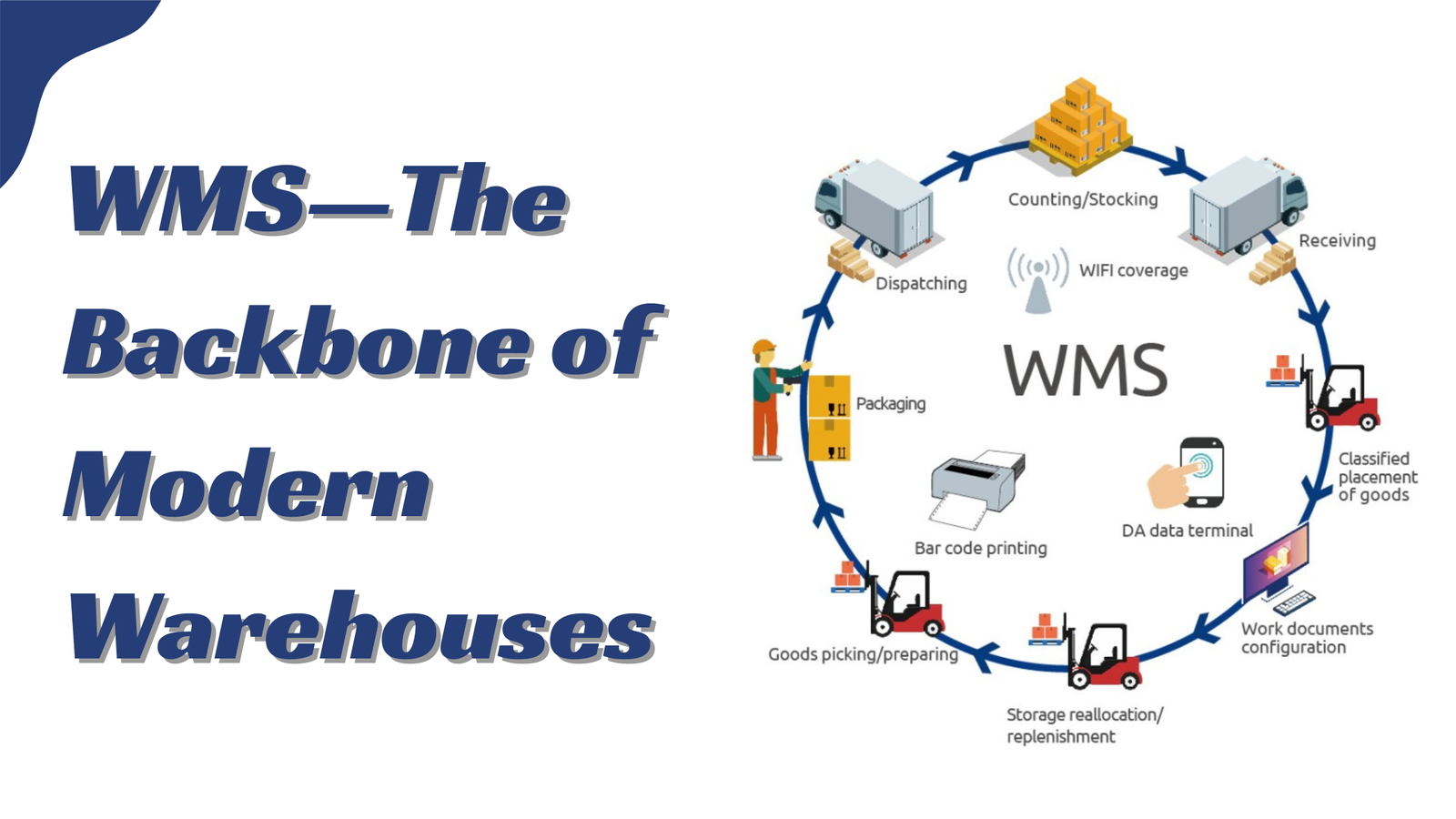WMS—The Backbone of Modern Warehouses
- 1 What is a WMS?
- 2 The Main Features of a WMS
- 3 When Do You Need a WMS?
- 3.1 Current Challenges
- 3.2 Operational Efficiency
- 3.3 Inventory Accuracy
- 3.4 Order Fulfillment Metrics
- 3.5 Future Growth
- 4 Steps for a Seamless WMS Implementation
- 4.1 1. Strategic Planning and Preparation
- 4.2 2. Comprehensive Data Audit and Cleansing
- 4.3 3. Seamless Integration with Existing Systems
- 4.4 4. Tailored Configuration and Customization
- 4.5 5. Effective Training and Onboarding
- 4.6 6. Rigorous Testing and Validation
- 4.7 7. Controlled Deployment and Go-Live
- 4.8 8. Ongoing Post-Implementation Support
- 5 Is WMS Implementation Challenging?
If you’re working in logistics or managing a warehouse, you’ve probably heard these acronyms multiple times: WMS, WCS, and WES. This article looks at the first one: WMS, which stands for Warehouse Management System. What is it, and when do you need it? Find it all out!
What is a WMS?
A Warehouse Management System (WMS) is a software solution designed to manage and control various warehouse operations. From tracking inventory to order fulfilment, a WMS provides the tools to streamline processes, reduce errors, and improve productivity. These systems offer real-time visibility into inventory levels, manage the movement of goods within the warehouse, and integrate with other business systems such as Enterprise Resource Planning (ERP) and Transportation Management Systems (TMS).
A WMS gives you complete insight into the operations within your facility. It’s a tool that can replace large teams of experts. Yes, it still needs human oversight and input; however, it can process much more data at once, helping your team locate bottlenecks and eliminate them, ensuring that your warehouse is optimized to the maximum.
The Main Features of a WMS
A WMS has many helpful features that will improve your warehouse’s operations. What are the most important ones? Here’s our list, explaining each of them in a nutshell.
- Inventory tracking—Real-time tracking of inventory levels and locations within the warehouse using barcode or RFID technology.
- Order management—Efficient processing and management of customer orders, including picking, packing, and shipping.
- Receiving and putaway—Managing the receipt of goods and optimizing storage locations.
- Picking and packing—Implementing efficient picking strategies to optimize the picking process and ensure accuracy.
- Shipping and documentation—Streamlining shipping processes, including carrier selection and label generation.
- Warehouse layout optimization—Configuring storage locations based on data to minimize travel distances and enhance efficiency.
- Labour management—Tracking and optimizing labour resources, including monitoring productivity and performance.
- Reporting and analytics—Generating reports on key warehouse metrics to identify areas for improvement and providing you with recommendations and predictive insights.
- Integration with other systems—Seamless integration with ERP, TMS, and other relevant software.
- Task automation—Automating routine tasks to reduce manual effort and minimize errors.
When Do You Need a WMS?
When to implement a WMS depends on several factors related to your current warehouse operations and business goals. So, while we won’t give you a straightforward answer to this question, we can provide you with a list of factors you should consider when deciding whether to implement a WMS.
Current Challenges
Identify existing challenges in your warehouse operations, such as inventory inaccuracies, slow order fulfilment, high labour costs, and inefficient space utilization. If these issues are prevalent, a WMS may be the panacea.
Operational Efficiency
Evaluate the efficiency of your current processes. Suppose tasks such as order picking, packing, and shipping are time-consuming and prone to errors. In that case, this might indicate that your team isn’t capable of analyzing all the data to streamline these operations—you need a software solution in the form of an AI-powered WMS.
Inventory Accuracy
Frequent discrepancies in inventory levels, stockouts, overstock situations, or struggles during peak season indicate that manual warehouse management is insufficient. In such cases, you should opt for a WMS—it provides real-time visibility and accurate inventory tracking, helping maintain optimal stock levels. Plus, you can use its data analytics to generate predictive insights and better prepare your inventory for sales peaks.
Order Fulfillment Metrics
Review metrics related to order fulfilment, such as processing time, accuracy, and on-time delivery rates. If these metrics are below industry standards or customer expectations, you need something extra to raise them—a Warehouse Management System.
Future Growth
If your business is growing or you anticipate increased order volumes, a scalable WMS solution can support this growth without requiring significant additional investment in infrastructure or human resources. The same goes for situations where your warehouse operations must scale along with shifting market demand. A WMS will maintain its efficiency despite the changing number of operations, providing you with the same level of support in the mentioned cases without increasing your overall operating costs.
Steps for a Seamless WMS Implementation
Implementing a Warehouse Management System (WMS) is a strategic move that can significantly enhance your warehouse operations. Here’s a detailed guide to each phase of the process to ensure a smooth and effective WMS implementation.
1. Strategic Planning and Preparation
The foundation of a successful WMS implementation lies in meticulous planning and preparation. Begin by assembling a dedicated implementation team, including a project manager, warehouse manager, database administrator, and a WMS specialist. This team will oversee the implementation process, ensuring that all aspects are comprehensively addressed.
Clearly defining your organizational goals and specific needs is crucial at this stage. Identify the objectives you aim to achieve with the WMS, such as improved inventory accuracy, enhanced productivity, or better customer service. Understanding your requirements will guide the selection and configuration of the WMS to align with your business goals.
2. Comprehensive Data Audit and Cleansing
Data integrity is paramount for the effective functioning of a WMS. Conduct a thorough audit of your existing data to ensure it is clean, accurate, and standardized. This step is often the most challenging but is essential to prevent issues during data migration. Precise data will enable the WMS to provide reliable insights and support informed decision-making.
3. Seamless Integration with Existing Systems
Integrating the WMS with your existing systems, such as Enterprise Resource Planning (ERP) and Transportation Management Systems (TMS), is critical for seamless operations. Depending on the chosen WMS solution, integration can range from requiring technical expertise to being straightforward with no-code or low-code solutions. Ensure that the WMS can effectively communicate with other systems to facilitate smooth data flow and coordination.
4. Tailored Configuration and Customization
Every warehouse has unique operational needs, making it essential to configure and customize the WMS accordingly. This involves setting up workflows, defining user roles, and customizing reports and dashboards to match your requirements. Collaborate closely with your WMS vendor during this phase, leveraging their expertise to tailor the system to your operational nuances.
5. Effective Training and Onboarding
User adoption is critical for the success of any new system. Provide comprehensive training to your team to ensure they are proficient in using the WMS. Implement training workshops and consider a buddy program where experienced users mentor those unfamiliar with the system. This approach fosters a supportive learning environment and enhances overall system effectiveness.
6. Rigorous Testing and Validation
Before the WMS goes live, extensive testing must be conducted to identify and resolve potential issues. This should include functional testing, performance testing, integration testing, and user acceptance testing. Involving end-users in testing ensures the system meets their needs and expectations. Thorough testing mitigates risks and ensures a smoother transition to the new system.
7. Controlled Deployment and Go-Live
Once testing is complete and any issues have been addressed, deploy the WMS. Consider a phased rollout or implement the system during off-peak periods to minimize operational disruption. Monitor the system closely during the initial phase to promptly address emerging issues. A controlled deployment ensures a smoother integration into daily operations.
8. Ongoing Post-Implementation Support
Continuous support and optimization are vital for the long-term success of the WMS. Establish a dedicated support team to handle user issues, monitor system performance, and provide regular updates and enhancements. Regularly review system performance metrics and gather user feedback to identify areas for improvement. Maintain an open line of communication with your vendor to leverage their support and expertise for ongoing system optimization.
Is WMS Implementation Challenging?
While the steps outlined may seem extensive, WMS implementation can be straightforward with proper planning and execution. Data quality often poses the most significant challenge, but diligent preparation can smooth the process. Integrating the system and training your team might require additional effort, but these steps are manageable and crucial for successfully deploying the WMS.
A well-implemented WMS can transform your warehouse operations, enhancing efficiency and accuracy. By following these steps and leveraging vendor expertise, you can navigate the implementation process effectively and achieve your organizational goals.

















